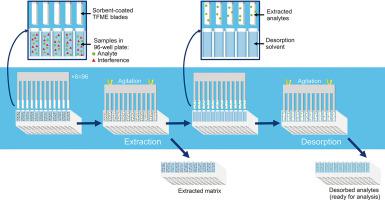Journal of Pharmaceutical Analysis ( IF 8.8 ) Pub Date : 2022-01-04 , DOI: 10.1016/j.jpha.2021.12.007 Łukasz Sobczak 1 , Dominika Kołodziej 1 , Krzysztof Goryński 1

|
For identifying and quantifying prohibited substances, solid-phase microextraction (SPME) continues to arouse interest as a sample preparation method. However, the practical implementation of this method in routine laboratory testing is currently hindered by the limited number of coatings compatible with the ubiquitous high-performance liquid chromatography (HPLC) systems. Only octadecyl (C18) and polydimethylsiloxane/divinylbenzene ligands are currently marketed for this purpose. To address this situation, the present study evaluated 12 HPLC-compatible coatings, including several chemistries not currently used in this application. The stationary phases of SPME devices in the geometry of thin film-coated blades were prepared by applying silica particles bonded with various functional ligands (C18, octyl, phenyl-hexyl, 3-cyanopropyl, benzenesulfonic acid, and selected combinations of these), as well as unbonded silica, to a metal support. Most of these chemistries have not been previously used as microextraction coatings. The 48 most commonly misused substances were selected to assess the extraction efficacy of each coating, and eight desorption solvent compositions were used to optimize the desorption conditions. All samples were analyzed using an HPLC system coupled with triple quadrupole tandem mass spectrometry. This evaluation enables selection of the best-performing coatings for quantifying prohibited substances and investigates the relationship between extraction efficacy and the physicochemical characteristics of the analytes. Ultimately, using the most suitable coatings is essential for trace-level analysis of chemically diverse prohibited substances.
中文翻译:

修改当前用于分析违禁物质的薄膜微萃取 (TFME) 解决方案:使用液相色谱法评估新涂层
为了识别和量化违禁物质,固相微萃取 (SPME) 作为一种样品制备方法继续引起人们的兴趣。然而,该方法在常规实验室测试中的实际实施目前受到与无处不在的高效液相色谱 (HPLC) 系统兼容的涂层数量有限的阻碍。目前仅销售十八烷基(C 18 ) 和聚二甲基硅氧烷/二乙烯基苯配体用于此目的。为了解决这种情况,本研究评估了 12 种与 HPLC 兼容的涂层,包括目前未用于该应用的几种化学物质。通过应用与各种功能配体键合的二氧化硅颗粒(C 18、辛基、苯基-己基、3-氰基丙基、苯磺酸和这些的选定组合)以及未键合的二氧化硅到金属载体上。大多数这些化学物质以前没有被用作微萃取涂层。选择了 48 种最常被误用的物质来评估每种涂层的提取效果,并使用八种解吸溶剂组合物来优化解吸条件。使用与三重四极杆串联质谱联用的 HPLC 系统分析所有样品。该评估能够选择性能最佳的涂层来量化禁用物质,并研究提取效率与分析物的物理化学特性之间的关系。最终,



























 京公网安备 11010802027423号
京公网安备 11010802027423号